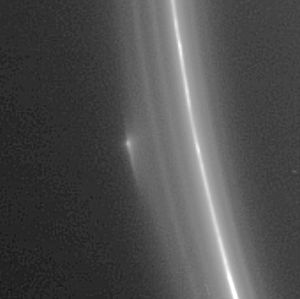S/2004 S 6 facts for kids
 object seen on 21 June, 2005 by Cassini, thought to be S/2004 S 6 |
|
| Discovery | |
|---|---|
| Discovered by | Cassini Imaging Science Team |
| Discovered on | 28 October, 2004 |
| Orbital characteristics | |
| Epoch 13 April 2005 (JD 2453474.1) | |
| Semimajor axis | 140,134 ± 2 km |
| Eccentricity | 0.00200 ± 0.00004 |
| Revolution period | 0.6180116 ± 0.0000004 d |
| Inclination to Saturn's equator |
0.002 ± 0.001° |
| Is a satellite of | Saturn |
| Physical characteristics | |
| Mean diameter | < 5 km |
| Rotation period | probably synchronous |
| Axial tilt | unknown |
| Albedo | unknown |
| Atmosphere | none |
S/2004 S 6 is a mysterious object that orbits the planet Saturn. It is found very close to one of Saturn's rings, called the F ring. Scientists are still trying to figure out if it is a small, solid moon or just a big clump of dust.
Contents
What is S/2004 S 6?
S/2004 S 6 is a name given to a dusty object near Saturn. It is special because it orbits very close to Saturn's F ring. Scientists are not sure if it is a solid, small moon or just a cloud of dust. This dust cloud might disappear over time.
Discovery of S/2004 S 6
Scientists first saw S/2004 S 6 in pictures taken by the Cassini-Huygens spacecraft. This happened on October 28, 2004. The discovery was announced a few days later, on November 8, 2004.
S/2004 S 6 has been seen many times since then. It is one of the best-tracked objects in this area of space. Other objects seen near the F ring, like S/2004 S 3 and S/2004 S 4, have been harder to find again.
Is it a Moon or Just Dust?
Even though S/2004 S 6 has been seen many times, scientists are still unsure. They do not know if it has a solid core, like a small moon. It might just be a clump of dust that could break apart.
For example, on November 15, 2004, Cassini took detailed pictures of the area. But S/2004 S 6 was not seen then. However, it was seen again later. This might be because S/2004 S 6 looks brighter when sunlight shines through its dust cloud from behind it. This means it might be mostly a cloud of fine dust, and any solid part is very small.
S/2004 S 6's Orbit and the F Ring
S/2004 S 6 moves in an orbit that crosses the F ring. This means it sometimes goes inside and sometimes outside the main F ring. Calculations show that it regularly passes through the ring material. For instance, on April 9, 2005, it came very close to the densest part of the ring.
Scientists think that this movement might create a spiral shape in the thinner parts of the F ring. It is like the object is plowing through the ring material.
Size of S/2004 S 6
The dusty cloud around S/2004 S 6 is quite large. It can stretch for about 2,000 kilometers (about 1,240 miles) in length. If there is a solid object at its center, it would be much smaller. Based on how bright it appears, this solid part would likely be no bigger than 3 to 5 kilometers (about 1.8 to 3.1 miles) across.
See also
 In Spanish: S/2004 S 6 para niños
In Spanish: S/2004 S 6 para niños

